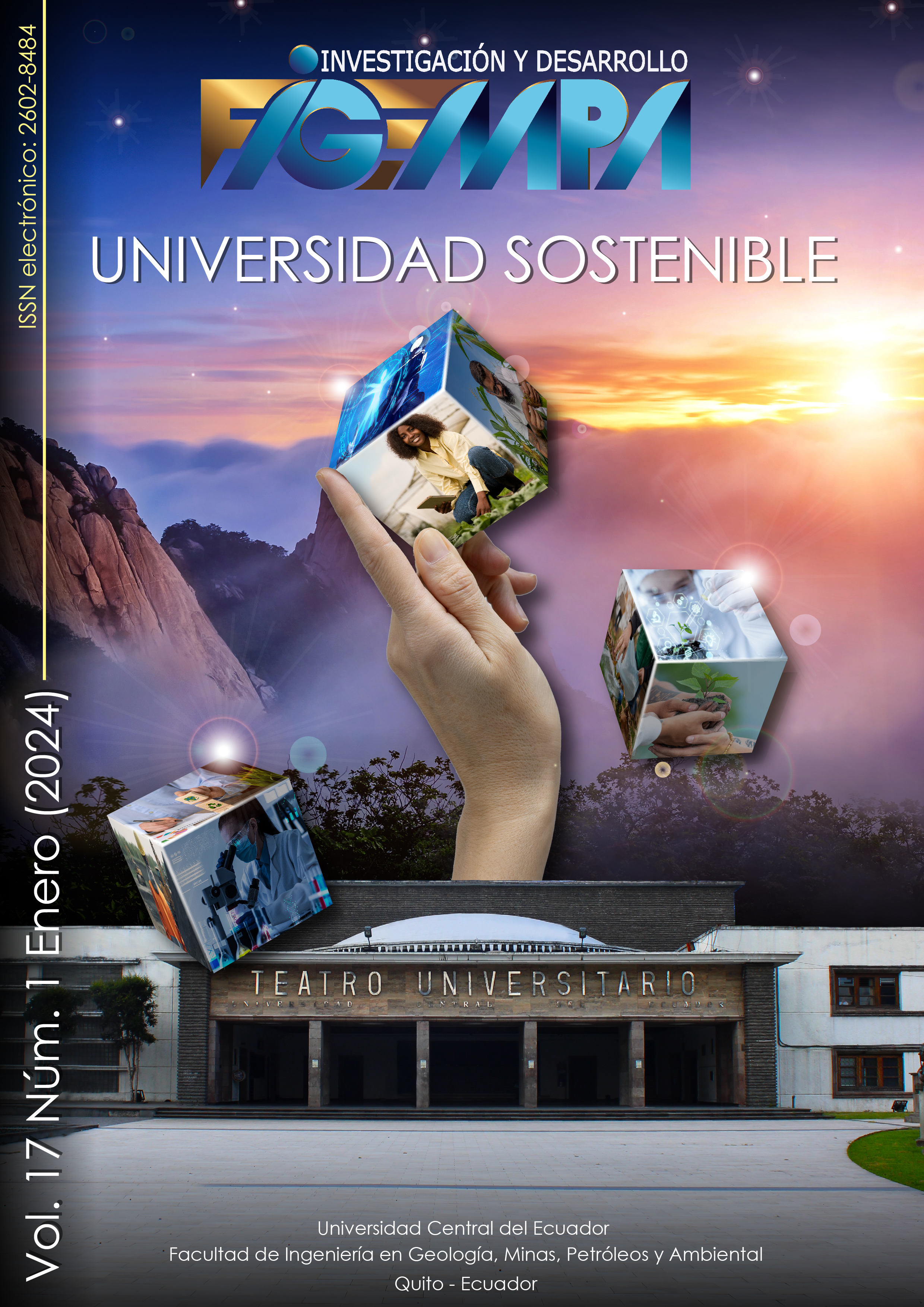Geomallas, una opción para el reforzamiento de suelos blandos bajo estructuras de hormigón armado
Contenido principal del artículo
Resumen
Los profesionales en construcción están a la vanguardia para reforzar el suelo con el uso y aplicación de métodos y materiales que ayuden a aumentar su capacidad portante, ya que, una de las causas principales de colapsos y asentamientos de edificaciones es el suelo blando. Para este estudio, se diseñó una edificación de cinco pisos de hormigón armado mediante un software estructural y se realizó un análisis de interacción suelo-estructura. Se calcularon los asentamientos inmediatos y diferenciales con la aplicación de las cargas provenientes de la estructura. Consideramos cuatro modelos de análisis de reforzamiento: 1) sin mejoramiento; 2) con sustitución del suelo; 3) con geomallas; y 4) con geomallas y reducción del ancho de zapata. El cálculo de la capacidad portante se estimó mediante datos de estudios de suelos y parámetros de materiales provenientes de canteras aledañas a la zona de estudio en Portoviejo, Ecuador. Se aplicó una adaptación a las fórmulas de Meyerhof & Hanna (1978) para la alternativa de sustitución del suelo, en cambio, para las geomallas se usó y aplicó las fórmulas de Huang & Meng (1997). Lo que se pretende con este análisis es obtener un valor alto de capacidad portante del suelo que conlleve ahorro de material de cimentación y a la vez alcanzar números bajos en los asentamientos que se deduzcan a la seguridad de la estructura. Los resultados del reforzamiento con relación al suelo natural revelaron un incremento considerable para las alternativas de geomallas en comparación con la sustitución del suelo, y una reducción en los asentamientos. Los porcentajes obtenidos luego del análisis y de los cálculos demuestran los beneficios del uso de geomallas bajo este tipo de estructuras.
Descargas
Métricas
Detalles del artículo

Esta obra está bajo una licencia internacional Creative Commons Atribución 4.0.
Citas
Alvarado, K. (2018) Mapa de Microzonificación Geotécnico y Modelo Geológico-Geotécnico 3D de la Ciudad de Portoviejo (Tesis de pregrado) Escuela Politécnica Nacional, Ecuador. http://bibdigital.epn.edu.ec/handle/15000/19473
Bernal, J. (2005) Hormigón Armado, Zapatas. 1ª Ed. ISBN13 9789875840171. Argentina: Nobuko.
Bowles, J. (1997) Foundation Analysis and Design. Fifth Edition, Singapore: McGraw-Hill Science, Engineering. ISBN 0-07-912247-7
Das, B. M. (2009) Shallow Foundations: Bearing Capacity and Settlement. 2nd Edition, Estados Unidos: CRC Press. ISBN 1420070061
Das, B. M. (2011) Fundamentos de ingeniería de cimentaciones. Séptima edición, México: Cengage Learning.
Das, B. M. (2014) Fundamentos de ingeniería geotécnica. Cuarta edición, México: Cengage Learning.
DGAVS (2019) Documento Básico: Seguridad estructural Cimientos. España: Dirección General de Arquitectura, Vivienda y Suelo.
DGC (2009) Guía de cimentaciones en obras de carreteras. España: Dirección General de Carreteras.
Escuela Politécnica Nacional EPN TECH EP (2017) Estudio de la microzonificación sísmica del área urbana de Portoviejo y sus cabeceras parroquiales rurales, Ecuador. Realizado en conjunto con el Instituto Geofísico Ecuatoriano (IGEPN), la Fundación Venezolana de Investigación Sismológica (FUNVISIS), la Pontificia Universidad Católica del Ecuador y el GAD de Portoviejo. https://docplayer.es/87719388-Michael-schmitz-estudios-de-microzonificacion-sismica-en-quito-y-portoviejo-ecuador.html
González de Vallejo, L. (2002) Ingeniería Geológica. España: Pearson Educación.
Huang, C. & Meng, F. (1997) Deep footing and wide-slab effects on reinforced sandy ground. Journal of Geotechnical and Geoenvironmental Engineering, 123 (1), pp. 30-36. https://doi.org/10.1061/(ASCE)1090-0241(1997)123:1(30)
Instituto Espacial Ecuatoriano [IEE] y Ministerio de Agricultura, Ganadería, Acuacultura y Pesca [MAGAP] (2012) Proyecto de Generación de Geoinformación a Escala 1: 25.000 a nivel nacional. Ecuador: Geoportal IGM. https://www.geoportaligm.gob.ec/descargas_prueba/portoviejo.html
Jiménez, J., De Justo, J. & Serrano, A. (1981) Geotecnia y cimientos II. Mecánica del suelo y de las rocas, España: Editorial Rueda. ISBN 8472070212
Koerner, R. (2005) Designing with geosynthetics. Fifth Edition, Estados Unidos: Pearson Prentice Hall.
Latha, G. & Somwanshi, A. (2009) Bearing capacity of square footings on geosynthetic reinforced sand. Geotextiles and Geomembranes, 27 (4), 281–294. https://doi.org/10.1016/j.geotexmem.2009.02.001
Meyerhof, G. & Hanna A. (1978.) Ultimate bearing capacity of foundation on layered soil under inclined load. Canadian Geotechnical Journal, 15 (4), 565-572. https://doi.org/10.1139/t78-060
Ministerio de Desarrollo Urbano y Vivienda [MIDUVI] (2014a) Norma Ecuatoriana de la Construcción: Peligro Sísmico Diseño Sismo Resistente. Ecuador. https://www.habitatyvivienda.gob.ec/documentos-normativos-nec-norma-ecuatoriana-de-la-construccion/
Ministerio de Desarrollo Urbano y Vivienda [MIDUVI] (2014b) Norma Ecuatoriana de la Construcción: Geotécnia y Cimentaciones. Ecuador. https://www.habitatyvivienda.gob.ec/wp-content/uploads/2023/03/7.-NEC-SE-GC-Geotecnia-y-Cimentaciones.pdf
Ministerio de Transporte y Obras Públicas [MTOP] (2013) Norma Ecuatoriana Vial. Volumen Nº 3 Especificaciones generales para la construcción de caminos y puentes. Ecuador. https://www.obraspublicas.gob.ec/wp-content/uploads/downloads/2013/12/01-12-2013_Manual_NEVI-12_VOLUMEN_3.pdf
Morrison, N. (1993) Interacción Suelo-Estructuras: Semi-espacio de Winkler (Tesis de maestría). Barcelona, España: Universidad Politécnica de Cataluña.
Sarmiento, J. (2017) Uso de geomallas y su importancia en la construcción de pavimentos en la provincia de Pisco, 2017 (Tesis de pregrado). Perú: Universidad Alas Peruanas. https://hdl.handle.net/20.500.12990/6655

